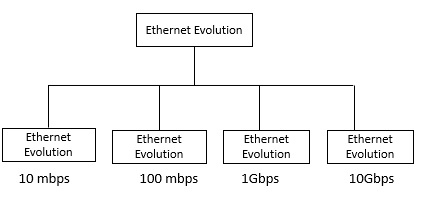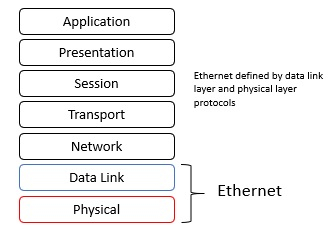
 Data Structure
Data Structure Networking
Networking RDBMS
RDBMS Operating System
Operating System Java
Java MS Excel
MS Excel iOS
iOS HTML
HTML CSS
CSS Android
Android Python
Python C Programming
C Programming C++
C++ C#
C# MongoDB
MongoDB MySQL
MySQL Javascript
Javascript PHP
PHP
- Selected Reading
- UPSC IAS Exams Notes
- Developer's Best Practices
- Questions and Answers
- Effective Resume Writing
- HR Interview Questions
- Computer Glossary
- Who is Who
What is Ethernet evolution in computer networks?
Ethernet was developed at Xerox PARC between 1973 and 1974. Engineer Bob Metcalfe invented it for interconnecting advanced computer workstations, making it possible to send data to one another and to high-speed laser printers.
It was originally intended to create a network in a small area known as a Local Area Network (LAN).
In 1983 the first iteration of Ethernet 10Base 5, was released.
In 1985 thin coaxial cable was approved and the group made changes to the specification in 1987, 1990 and 1993.
In 1995 so called Fast Ethernet introduced it contains speed and duplex mode (both side transmitting at same time)
In 1998 it became a 1Gbps network thanks to the fibre optics which makes it possible the IEEE approves 1 Gbps over twisted pair one year later.
In 2002 Ethernet hit the 10 Gbps milestone for fibre transmission while 10 Gbps over unshielded twisted pairs became reality in 2006.
The Ethernet evolution is diagrammatically represented as follows −

So, Ethernet is a way of connecting computers together in LAN, it is the most widely used method of linking computers together in LANs. The basic idea of its design is that multiple computers have access to it and can send data at any time.
Standard Ethernet is also called classical Ethernet.
Fast, Gigabit and 10 Gigabit are called switched Ethernets.

Ethernet operates across two layers of OSI models. The model provides a reference to which ethernet can be related but it is actually implemented in the lower half of the data link layer, which is called as Medium Access control (MAC) sublayer and the physical layer only.
Ethernet at layer 1 involves signals, and bit streams that travel on the media, physical components that put signals on media, and various topologies. Ethernet Layer 1 performs a main role in the communication which takes place between devices, but each of its functions has their limitations.
Ethernet offers a combination of benefits that make it an effective networking choice −
- Cost effective
- Easy to use
- Scalable and flexible
- A real alternative

